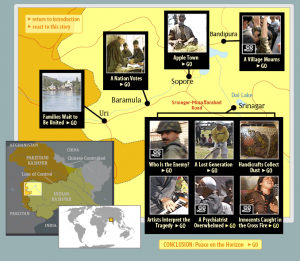By Denis Devine (class of 2004)
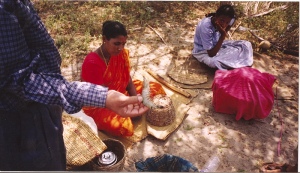
A shrimp for sale in Killai, India, harvested from the bank of the Uppanar River. Lately, the vendor said, her baskets haven't been very full, due to competition from nearby shrimp farms. Photo by Denis Devine.
KILLAI, Tamil Nadu, May 24, 2004—America’s favorite seafood has left this small fishing village with an aftertaste too bitter to be concealed by cocktail sauce.
Last September, an angry mob gathered in Killai’s open-air meeting hall and decided to seek its own brand of justice. Fed up with poverty, pollution and government indifference, hundreds of fishermen marched after midnight to attack an industry they say is ruining their land and water. Their target: shrimp farms whose crops end up as appetizers and entrees at sports bars and family restaurants throughout the United States.
Some poor people throughout the developing world are paying a high price for cheap shrimp, while others strike it rich. The booming shrimp-farming business of the last two decades has transformed much of the coastlines and bottom lines of tropical South Asia and Latin America, but the fishermen in this remote corner of southeast India’s Tamil Nadu state believe shrimp farming has their centuries-old traditions under siege.
On September 18th, 2003, fishermen from Killai and neighboring villages crept onto nearby ponds full of growing shrimp, opened the dams and let the water drain out. Crowds of women were beaten in a violent, pre-dawn raid by police the next morning, prompting investigations into human rights violations. Almost 100 men and women would be arrested in the following days. Now, the people of Killai want to enlist the help of Americans.

V. K. Sezhiyan, a Killai fishermen, urges Americans not to eat farmed shrimp.
“Tell them, don’t eat these prawns that are produced out of our lives, out of our blood,” said V. K. Sezhiyan, one of the village’s elder fishermen.
U.S. seafood lovers will soon be able to heed Sezhiyan’s call. “Country-of-origin” labels are scheduled to become mandatory for imported shrimp and other seafood this fall, and the labels will also tell shoppers whether the product was caught in the wild or raised on farms. But no label will convey the anguish of Killai’s fishermen as they watch their traditional way of life slip through their nets.
The technological advances and chemical enhancements of the late 20th Century’s “Blue Revolution” rapidly transformed fish-farming from a small-scale, rural tradition to today’s high-tech, global industry. Modern industrial aquaculture is often touted as the best hope for feeding a growing population as fish stocks disappear and for helping poor nations recover from massive debt. Derided as a “pink gold rush” by its critics, shrimp farming is the most profitable and largest front in the Blue Revolution.
Underwritten by international development loans, global production of farm-raised shrimp grew by 300 percent between 1975 and 1985 and 250 percent between 1985 and 1995. The industry is still growing, up 10.5 percent in the last four years, and farm-raised shrimp are gobbling up the expanding market. In the early 1980s, only five percent of the world’s shrimp were farm-raised; last year, shrimp farms produced about 35 percent – or 3.5 billion pounds – of the global shrimp supply.
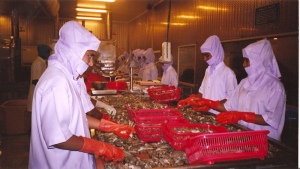
Young women de-head shrimp at a modern shrimp processing plant in Chennai, India. Photo by Denis Devine.
Thanks to this flood of farmed imports, American seafood lovers have seen shrimp transformed in recent years from a locally-caught luxury dish to a cheap, ubiquitous staple at sports bars and fast-food chains. Since overtaking tuna in 2001, shrimp has been America’s most popular seafood. The United States is the biggest shrimp importer in the world, and gets about 90 percent of its shrimp from farms throughout the developing world, like those in Killai.
This global glut of cheap, farmed shrimp also threatens the livelihoods of the men and women who catch wild shrimp around the world, including the United States. Shrimp imports from the U.S.’s top six suppliers – China, Vietnam, Ecuador, Brazil, Thailand and India – jumped 67 percent over the last three years, while wholesale prices dropped 28 percent.
While Killai’s fishermen struck back against the shrimp farms themselves, their counterparts in the U.S. took the industry to court. The U.S. International Trade Commission is reviewing an anti-dumping petition against those six shrimp importing countries filed by a coalition of shrimpers, dock owners and shrimp processors from Alabama, Georgia, Louisiana, Mississippi, Texas and North and South Carolinas.
The Southern Shrimp Alliance charges the Asian and South American nations with selling their shrimp in the U.S. cheaper than it costs their shrimp farmers to grow them, or cheaper than what shrimp sells for in similar export markets – thus “dumping” artificially cheap shrimp on our shores. This “dumping,” the alliance claims, has caused the value of the U.S. shrimpers’ harvest to plunge 50 percent between 2000 and 2002 and southern shrimp processing plants to lay off 40 percent of their workers. A decision is expected in July; if the petition is successful, shrimp imports from the top six countries will be tagged with high tariffs to make the domestic shrimp more comparable in price.
Shrimp farming’s proponents says shrimp fishing is an outdated industry that can’t compete in a globalized market.
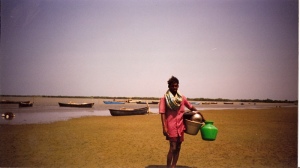
At low tide on the Uppanar River, a Killai fisherman returns from washing his boat. Photo by Denis Devine.
“The fisherman is being outcompeted, and is bewildered by it because he has always been able to get top dollar for his shrimp,” said Bob Rosenberry, the editor of Shrimp News International, a leading shrimp aquaculture industry newsletter. “The fishermen’s cost of production might be $2 per pound, whereas in shrimp farms in Asia, they’re getting a dollar a pound. As far as I can see, the writing is on the wall for the U.S. shrimp fisherman.”
In Killai, too, the fishermen worry about the low prices their dwindling catches are fetching on the market.
“Thousands and thousands of fishermen economically benefited” from Killai’s shrimp fishing heritage, said Sezhiyan, a 51-year-old father of three. “But since shrimp industries come into existence, only a few families enormously accumulated wealth at the cost of our lives.”
But in Killai and around the world, shrimp farming’s opponents are more likely to talk about the industry’s environmental impacts than its economics. They accuse the aquaculture industry of privatizing public land and exploiting natural resources at the expense of traditional coastal communities, and reserve their harshest criticism for shrimp farming.
Opponents blame shrimp farming’s hunger for coastal lands for the destruction of as much as 38 percent of the world’s mangrove forests. Forests like the 3,000-acre Pitchavaram Mangrove Forest Reserve that surrounds Killai are valuable to people as storm protection and food source, and invaluable to fish and crustaceans that feed and nurse amid the shelter of the tangled underwater roots.
Shrimp farming’s use of brackish water in its ponds has been blamed for the salinization of drinking water and agricultural land in most of the developing nations where the industry has flourished. Salty soil around the brick and palm-leaf homes in Killai has killed coconut trees and groundnuts that once provided villagers extra food and income. Local women must walk farther and farther to find a well with water that isn’t too salty to drink.
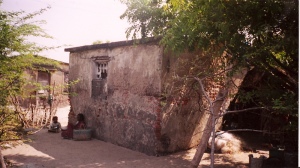
The villagers of Killai say this brick home is crumbling due to the salty runoff from nearby shrimp farms. Photo by Denis Devine.
Opponents say the chemicals and fertilizers used to keep the pondwater hospitable for shrimp kill fish and cause plankton blooms once the ponds are drained into the open water. Killai’s fishermen say their nets are catching fewer fish and shrimp and blame the 60 shrimp farms that have swallowed up acres of farmland and mangrove forests along the banks of the Uppanar River since 1994.
The international shrimp industry has been trying to cleap up its act. Pressure from environmental groups and importers in the U.S., Europe and Japan has pushed the seafood industry to develop voluntary codes of conduct and Best Management Practices that strive to make shrimp farming economically and environmentally sustainable. International market pressures for traceability and improved sanitary conditions have raised the bar for an increasingly industrialized commodity industry.
Government regulation is growing more sophisticated in the nations where shrimp farming boomed first, including India, where a new Aquaculture Authority is attempting to rein in shrimp farming’s bad actors with voluntary guidelines for sustainable shrimp farming.
To Killai’s fishermen, the government’s actions are too little, too late. They worry most about their children’s future, as they are no longer able to save enough money to send their children to college. Though they lamented the increasing migration of hundreds of their friends and relatives to the cities in search of work, Killai’s fishermen said they hoped their children would follow that same road out of the village.
“I want my children to be educated to get a good job,” said Sezhiyan of his three children. “I don’t want them to undergo the same suffering and uncertainties and unguaranteed life, because there is no regular income from fishing.”
Read the full version of this story


